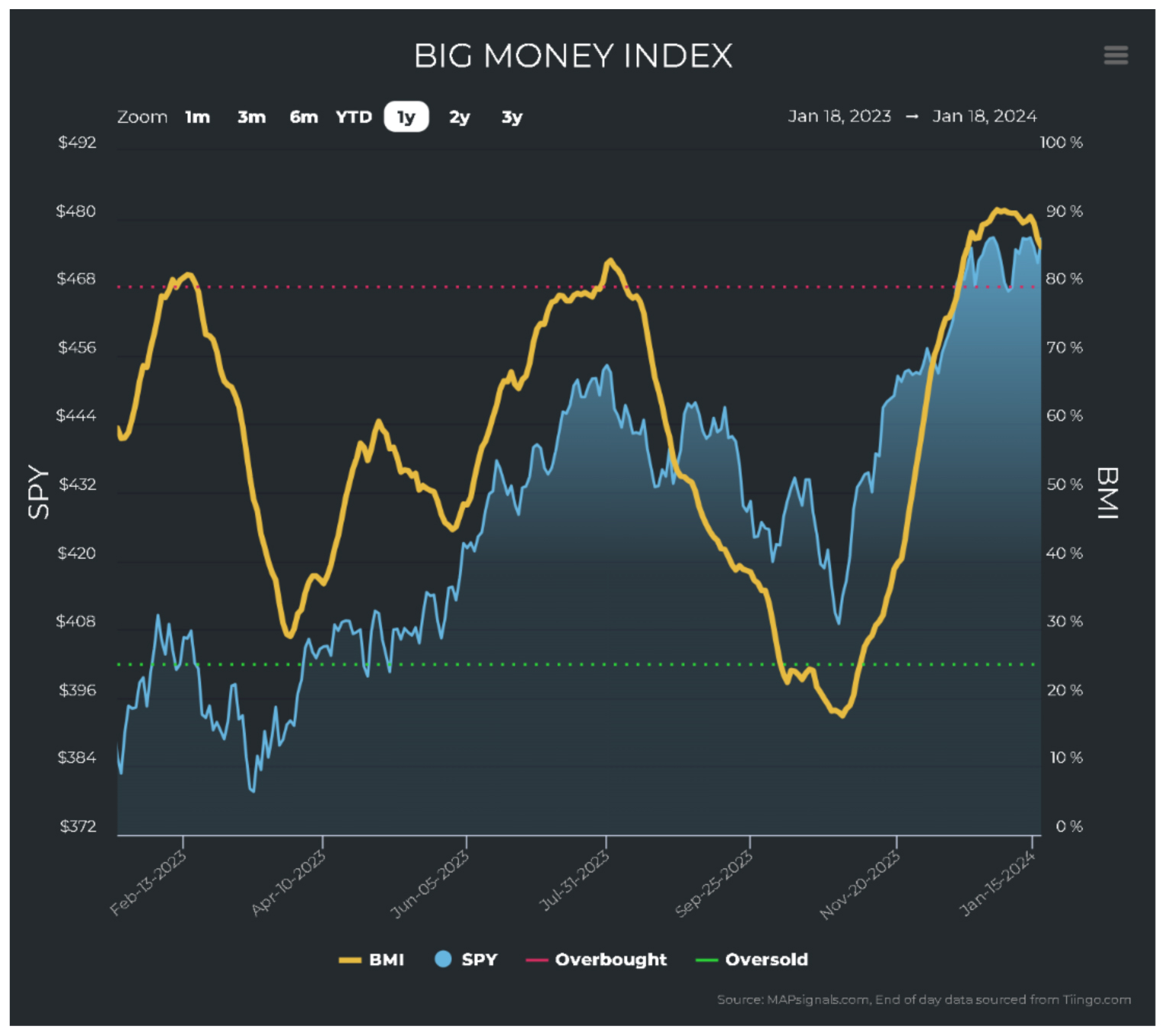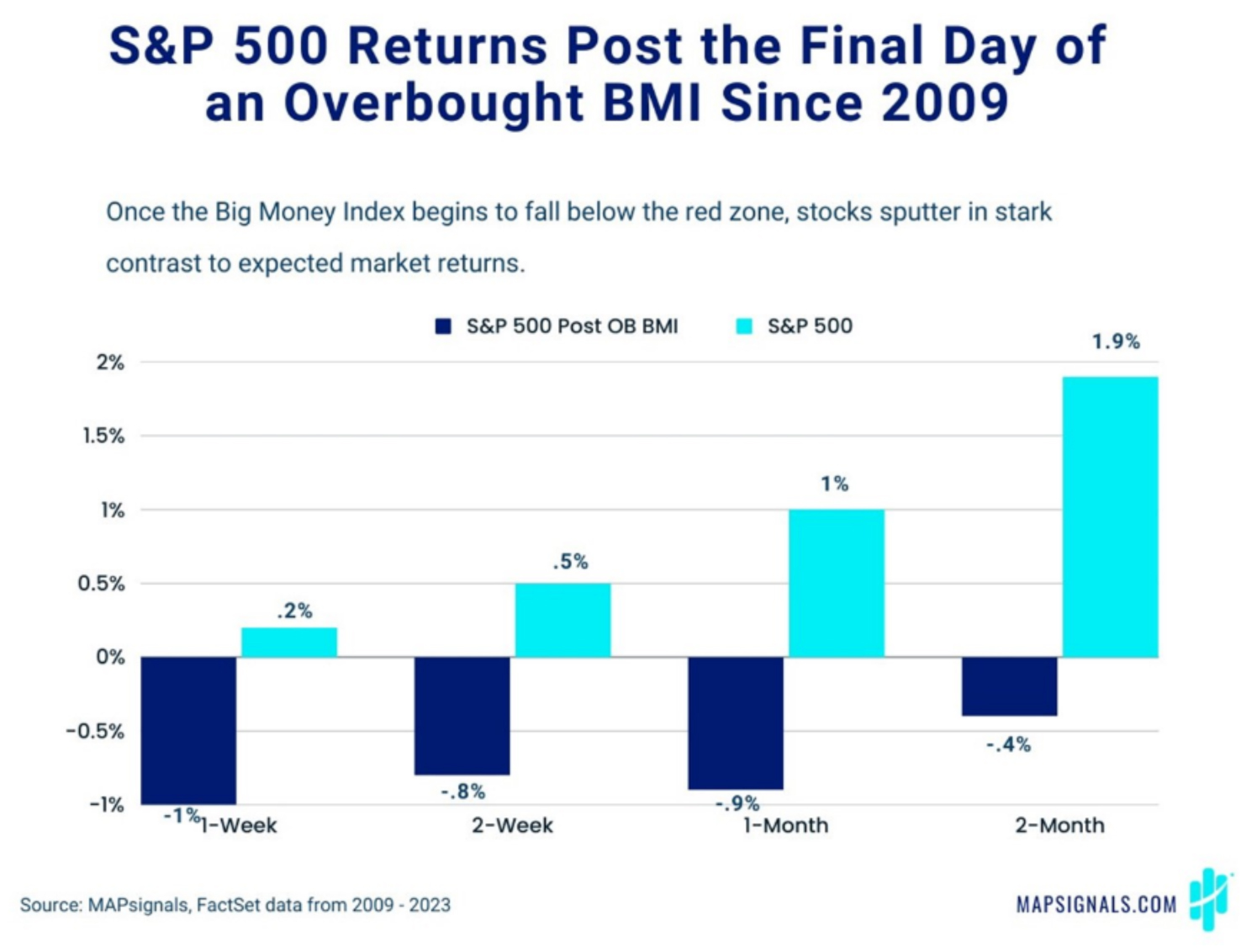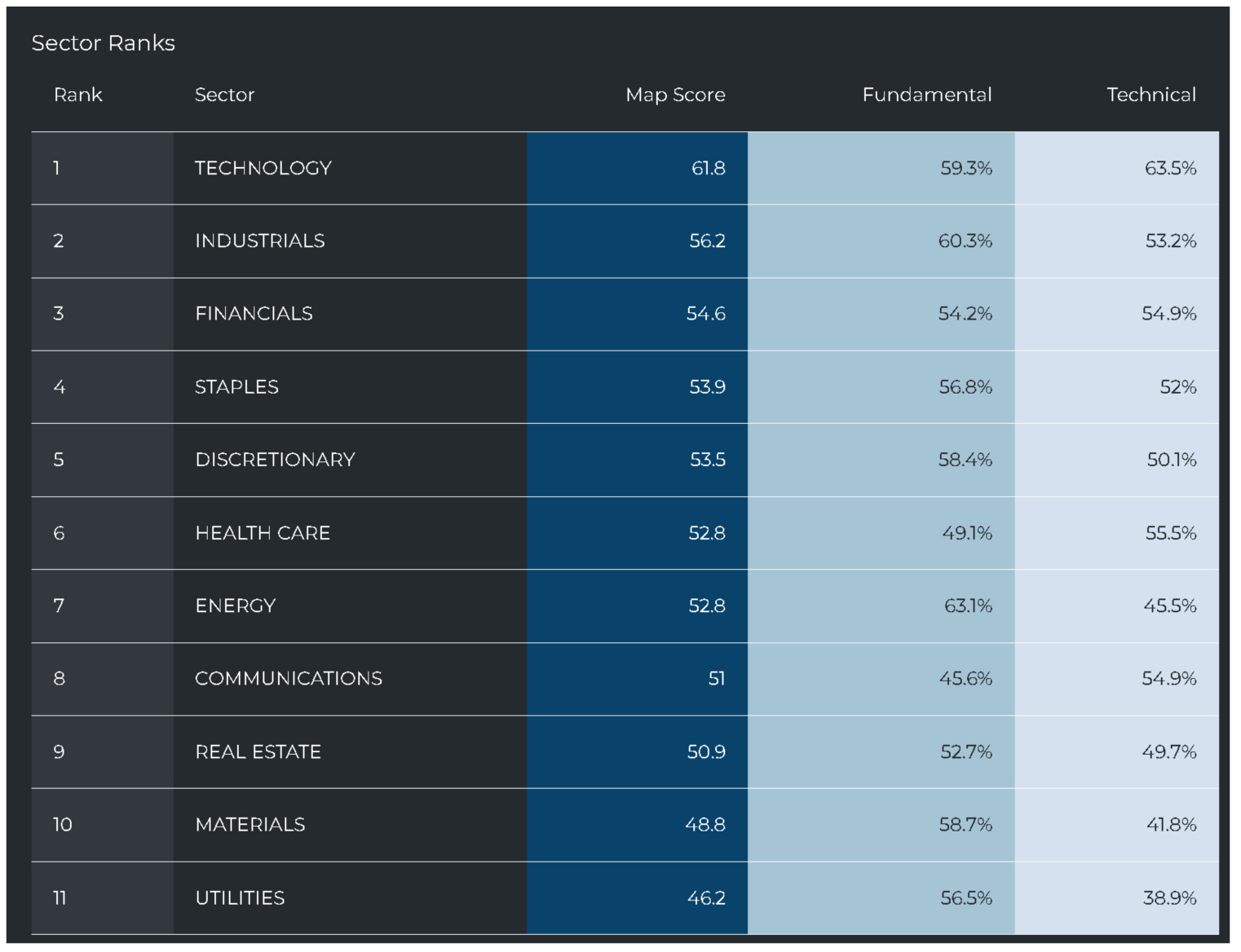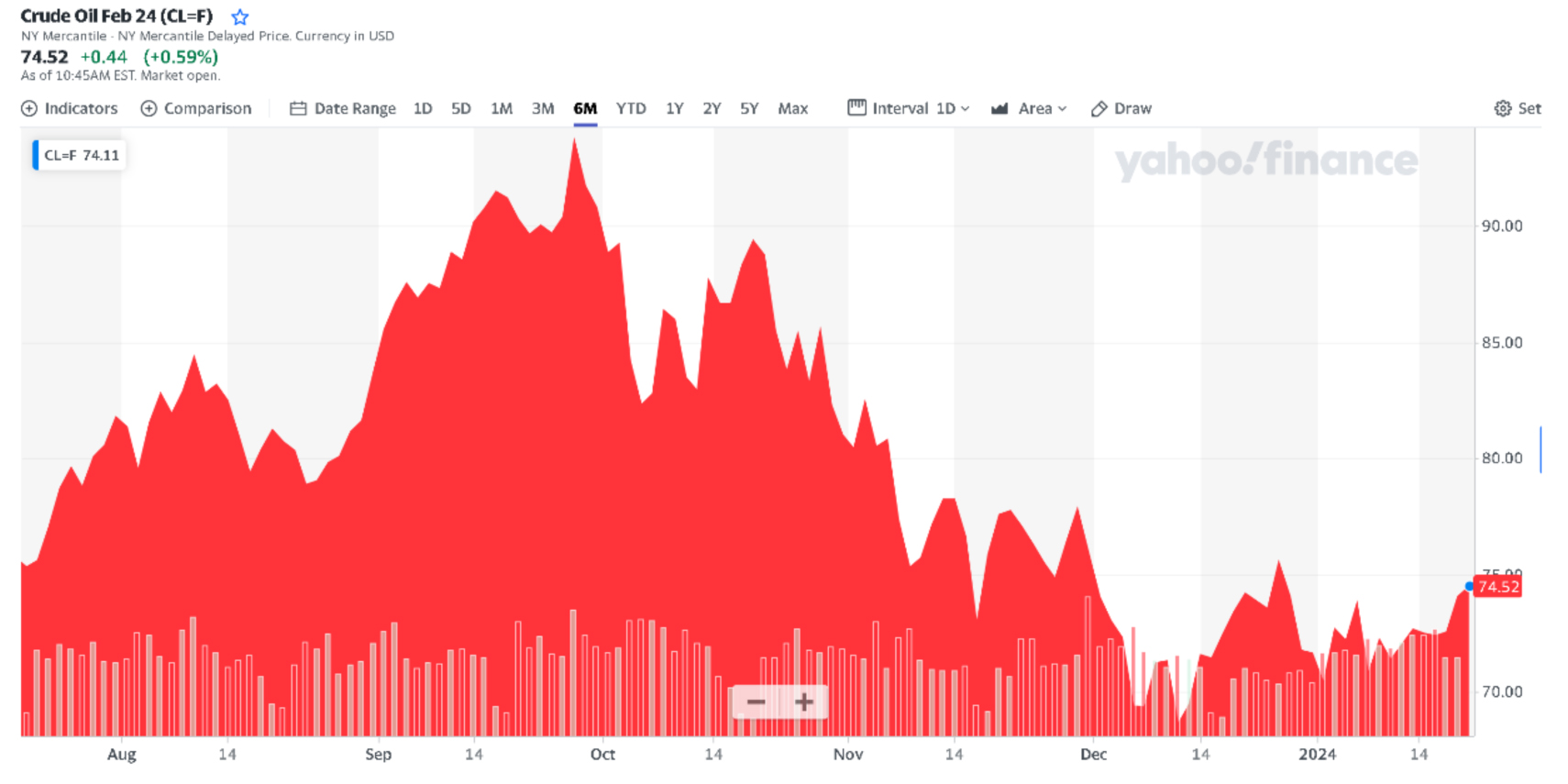by Jason Bodner
January 23, 2024
Feeling blue?
That expression came from sailing. When a ship lost their captain at sea, they would fly a blue flag.
Feeling that way about your investments is understandable, with negative news constantly swirling around. War, politics, inflation, and a holiday hangover can put anyone into a funk. Feeling blue makes sense, but I’ll give some reasons not to feel blue, and also reasons to keep your eyes on the horizon.
Markets grind on. Despite a stumbling start to the year, stocks quickly navigated the storm and righted the ship. The QQQ (the NASDAQ 100 tracking ETF) hit an all-time high the other day. Tech is back on top as the reigning sector, and all seems calm at sea. While we enjoy our smooth sailing, today we will go into what to expect in the coming weeks and what to look for as potential signs of clouds on the horizon.
The first thing to watch for from the crow’s nest is the Big Money Index (BMI). For those unaware of this tool, it is a powerful indicator of unusual money flows. When it (the amber line in the chart below) is rising, it indicates money flowing in. When it falls, big money is flowing out. What we see in the chart below is that money gushed into stocks starting in early November and it hasn’t really stopped:

Graphs are for illustrative and discussion purposes only. Please read important disclosures at the end of this commentary.
The important lines are the red and green dotted lines. When the BMI rises above red, it indicates that 80% or more of all unusual trading activity in the prior 25 days was on the buy side. The red line indicates that such a level of buying is unsustainable: The market is overbought. Now if you’ve been following me, you’ll know that this by itself is not a signal to reduce risk and raise cash. As I have highlighted before, the BMI can stay overbought for quite a while. In fact, during COVID, the BMI remained overbought for 84 days, from May 6 to September 2, 2020. Here are some useful statistics about an overbought BMI:
• It happened 72 times since 1990.
• It lasts an average of 22 trading days or about one calendar month.
• It takes an average of 16 calendar days to peak.
• On average, returns are positive 1, 3, 6, 9 and 12 months after the first day of overbought.

Perhaps more importantly, we need to watch for when the BMI falls out of overbought. That’s the time when we can expect softer market performance. Looking at the chart below, we can see that the post-overbought BMI predicts weaker returns (dark blue) versus that of average S&P 500 returns (light blue):

Graphs are for illustrative and discussion purposes only. Please read important disclosures at the end of this commentary.
Sail on – as we have not broken below overbought just yet.
Things actually look quite healthy in terms of unusual buying and selling. In the following chart, we see that stocks and ETFs are seeing consistent buying that are nowhere near extreme levels:

Graphs are for illustrative and discussion purposes only. Please read important disclosures at the end of this commentary.
This tells us that, despite an overbought market, the winds haven’t shifted direction yet. Buying is still happening at a nice healthy constructive clip. It is also interesting to see where the buying is happening in terms of sectors. I mentioned before that NASDAQ made a new high. And we can see the echoes of that in which sectors are rising to the top of our strength rankings. Tech stocks have once again taken the lead. Some other sectors at the top of the list are growth-oriented too, as we see Industrials, Financials, and Discretionary stocks in the top five. Financials are poised to do well in a high interest rate environment. It’s unsurprising that Discretionary stocks slip a bit after the holiday binge buying is behind us.

Graphs are for illustrative and discussion purposes only. Please read important disclosures at the end of this commentary.
When we delve into the distribution of buying and selling last week, we again see tech racking up 40% of all buys. We saw buying in hardware stocks, networking companies, semi manufacturers, chip-makers, and software. And while Discretionary stocks ranked 5th in sector ranks, they ranked second in unusual buying. We saw home-builders, hotels and leisure, retailers, and restaurants getting accumulated.

Graphs are for illustrative and discussion purposes only. Please read important disclosures at the end of this commentary.
My first thought after seeing this data is that these are the profiles of stocks that don’t get bought up before a meltdown. In other words, investors are buying growth, not shying away from it. Selling was not substantial, but nearly half of whatever selling there was resided in energy stocks. This makes sense as the price of oil retreated from a high of nearly $94 per barrel down to $74.50 – a -20% drop.

Graphs are for illustrative and discussion purposes only. Please read important disclosures at the end of this commentary.
Clearly, lower oil prices impact margins on oil producers. I should add that if there is any progress on peace talks in the Middle East or on the Russia-Ukraine front, it would further ease oil prices which would likely increase selling of oil stocks. As of now – no one has any clarity on that front though.
Sometimes we know something is going to happen, like now. We know the BMI will eventually fall from overbought. We don’t know precisely when, but we have a good idea based on history. The averages tell us that the BMI should fall from overbought 22 days after going overbought. That works out to January 19th – clearly not happening given the current environment. We know it will fall, but this could go on for a while. The best course of action is to stay on the current course and react as new data comes in.
Growth is in favor, and despite the market invariably falling from overbought in the future, there are more reasons why 2024 should be strong:
• There is more than $6.14 trillion sitting in cash – the highest on record.
• Inflation is falling with CPI at 3.4%. It continues to fall even faster on a 6-month basis.
• The target rate of 5.25-5.50% is 60% higher than inflation by the highest measure. That’s a lot!
• The recession hard-landing never came.
Smooth seas are here, for now, but they never last.
Or, as Franklin D, Roosevelt so aptly said: “A smooth sea never made a skilled sailor.”
All content above represents the opinion of Jason Bodner of Navellier & Associates, Inc.
Also In This Issue
A Look Ahead by Louis Navellier
European Leaders Are Anxious About a Possible Trump Win
Income Mail by Bryan Perry
It Seems Like Living With 3%-4% Inflation Is OK With Mr. Market
Growth Mail by Gary Alexander
The Monthly Jobs Data is Bogus and Premature…
Global Mail by Ivan Martchev
Fresh All-Time Highs Across the Board
Sector Spotlight by Jason Bodner
My Cure for Any Market Blues
View Full Archive
Read Past Issues Here

Jason Bodner
MARKETMAIL EDITOR FOR SECTOR SPOTLIGHT
Jason Bodner writes Sector Spotlight in the weekly Marketmail publication and has authored several white papers for the company. He is also Co-Founder of Macro Analytics for Professionals which produces proprietary equity accumulation/distribution research for its clients. Previously, Mr. Bodner served as Director of European Equity Derivatives for Cantor Fitzgerald Europe in London, then moved to the role of Head of Equity Derivatives North America for the same company in New York. He also served as S.V.P. Equity Derivatives for Jefferies, LLC. He received a B.S. in business administration in 1996, with honors, from Skidmore College as a member of the Periclean Honors Society. All content of “Sector Spotlight” represents the opinion of Jason Bodner
Important Disclosures:
Jason Bodner is a co-founder and co-owner of Mapsignals. Mr. Bodner is an independent contractor who is occasionally hired by Navellier & Associates to write an article and or provide opinions for possible use in articles that appear in Navellier & Associates weekly Market Mail. Mr. Bodner is not employed or affiliated with Louis Navellier, Navellier & Associates, Inc., or any other Navellier owned entity. The opinions and statements made here are those of Mr. Bodner and not necessarily those of any other persons or entities. This is not an endorsement, or solicitation or testimonial or investment advice regarding the BMI Index or any statements or recommendations or analysis in the article or the BMI Index or Mapsignals or its products or strategies.
Although information in these reports has been obtained from and is based upon sources that Navellier believes to be reliable, Navellier does not guarantee its accuracy and it may be incomplete or condensed. All opinions and estimates constitute Navellier’s judgment as of the date the report was created and are subject to change without notice. These reports are for informational purposes only and are not a solicitation for the purchase or sale of a security. Any decision to purchase securities mentioned in these reports must take into account existing public information on such securities or any registered prospectus.To the extent permitted by law, neither Navellier & Associates, Inc., nor any of its affiliates, agents, or service providers assumes any liability or responsibility nor owes any duty of care for any consequences of any person acting or refraining to act in reliance on the information contained in this communication or for any decision based on it.
Past performance is no indication of future results. Investment in securities involves significant risk and has the potential for partial or complete loss of funds invested. It should not be assumed that any securities recommendations made by Navellier. in the future will be profitable or equal the performance of securities made in this report. Dividend payments are not guaranteed. The amount of a dividend payment, if any, can vary over time and issuers may reduce dividends paid on securities in the event of a recession or adverse event affecting a specific industry or issuer.
None of the stock information, data, and company information presented herein constitutes a recommendation by Navellier or a solicitation to buy or sell any securities. Any specific securities identified and described do not represent all of the securities purchased, sold, or recommended for advisory clients. The holdings identified do not represent all of the securities purchased, sold, or recommended for advisory clients and the reader should not assume that investments in the securities identified and discussed were or will be profitable.
Information presented is general information that does not take into account your individual circumstances, financial situation, or needs, nor does it present a personalized recommendation to you. Individual stocks presented may not be suitable for every investor. Investment in securities involves significant risk and has the potential for partial or complete loss of funds invested. Investment in fixed income securities has the potential for the investment return and principal value of an investment to fluctuate so that an investor’s holdings, when redeemed, may be worth less than their original cost.
One cannot invest directly in an index. Index is unmanaged and index performance does not reflect deduction of fees, expenses, or taxes. Presentation of Index data does not reflect a belief by Navellier that any stock index constitutes an investment alternative to any Navellier equity strategy or is necessarily comparable to such strategies. Among the most important differences between the Indices and Navellier strategies are that the Navellier equity strategies may (1) incur material management fees, (2) concentrate its investments in relatively few stocks, industries, or sectors, (3) have significantly greater trading activity and related costs, and (4) be significantly more or less volatile than the Indices.
ETF Risk: We may invest in exchange traded funds (“ETFs”) and some of our investment strategies are generally fully invested in ETFs. Like traditional mutual funds, ETFs charge asset-based fees, but they generally do not charge initial sales charges or redemption fees and investors typically pay only customary brokerage fees to buy and sell ETF shares. The fees and costs charged by ETFs held in client accounts will not be deducted from the compensation the client pays Navellier. ETF prices can fluctuate up or down, and a client account could lose money investing in an ETF if the prices of the securities owned by the ETF go down. ETFs are subject to additional risks:
- ETF shares may trade above or below their net asset value;
- An active trading market for an ETF’s shares may not develop or be maintained;
- The value of an ETF may be more volatile than the underlying portfolio of securities the ETF is designed to track;
- The cost of owning shares of the ETF may exceed those a client would incur by directly investing in the underlying securities; and
- Trading of an ETF’s shares may be halted if the listing exchange’s officials deem it appropriate, the shares are delisted from the exchange, or the activation of market-wide “circuit breakers” (which are tied to large decreases in stock prices) halts stock trading generally.
Grader Disclosures: Investment in equity strategies involves substantial risk and has the potential for partial or complete loss of funds invested. The sample portfolio and any accompanying charts are for informational purposes only and are not to be construed as a solicitation to buy or sell any financial instrument and should not be relied upon as the sole factor in an investment making decision. As a matter of normal and important disclosures to you, as a potential investor, please consider the following: The performance presented is not based on any actual securities trading, portfolio, or accounts, and the reported performance of the A, B, C, D, and F portfolios (collectively the “model portfolios”) should be considered mere “paper” or pro forma performance results based on Navellier’s research.
Investors evaluating any of Navellier & Associates, Inc.’s, (or its affiliates’) Investment Products must not use any information presented here, including the performance figures of the model portfolios, in their evaluation of any Navellier Investment Products. Navellier Investment Products include the firm’s mutual funds and managed accounts. The model portfolios, charts, and other information presented do not represent actual funded trades and are not actual funded portfolios. There are material differences between Navellier Investment Products’ portfolios and the model portfolios, research, and performance figures presented here. The model portfolios and the research results (1) may contain stocks or ETFs that are illiquid and difficult to trade; (2) may contain stock or ETF holdings materially different from actual funded Navellier Investment Product portfolios; (3) include the reinvestment of all dividends and other earnings, estimated trading costs, commissions, or management fees; and, (4) may not reflect prices obtained in an actual funded Navellier Investment Product portfolio. For these and other reasons, the reported performances of model portfolios do not reflect the performance results of Navellier’s actually funded and traded Investment Products. In most cases, Navellier’s Investment Products have materially lower performance results than the performances of the model portfolios presented.
This report contains statements that are, or may be considered to be, forward-looking statements. All statements that are not historical facts, including statements about our beliefs or expectations, are “forward-looking statements” within the meaning of The U.S. Private Securities Litigation Reform Act of 1995. These statements may be identified by such forward-looking terminology as “expect,” “estimate,” “plan,” “intend,” “believe,” “anticipate,” “may,” “will,” “should,” “could,” “continue,” “project,” or similar statements or variations of such terms. Our forward-looking statements are based on a series of expectations, assumptions, and projections, are not guarantees of future results or performance, and involve substantial risks and uncertainty as described in Form ADV Part 2A of our filing with the Securities and Exchange Commission (SEC), which is available at www.adviserinfo.sec.gov or by requesting a copy by emailing info@navellier.com. All of our forward-looking statements are as of the date of this report only. We can give no assurance that such expectations or forward-looking statements will prove to be correct. Actual results may differ materially. You are urged to carefully consider all such factors.
FEDERAL TAX ADVICE DISCLAIMER: As required by U.S. Treasury Regulations, you are informed that, to the extent this presentation includes any federal tax advice, the presentation is not written by Navellier to be used, and cannot be used, for the purpose of avoiding federal tax penalties. Navellier does not advise on any income tax requirements or issues. Use of any information presented by Navellier is for general information only and does not represent tax advice either express or implied. You are encouraged to seek professional tax advice for income tax questions and assistance.
IMPORTANT NEWSLETTER DISCLOSURE:The hypothetical performance results for investment newsletters that are authored or edited by Louis Navellier, including Louis Navellier’s Growth Investor, Louis Navellier’s Breakthrough Stocks, Louis Navellier’s Accelerated Profits, and Louis Navellier’s Platinum Club, are not based on any actual securities trading, portfolio, or accounts, and the newsletters’ reported hypothetical performances should be considered mere “paper” or proforma hypothetical performance results and are not actual performance of real world trades. Navellier & Associates, Inc. does not have any relation to or affiliation with the owner of these newsletters. There are material differences between Navellier Investment Products’ portfolios and the InvestorPlace Media, LLC newsletter portfolios authored by Louis Navellier. The InvestorPlace Media, LLC newsletters contain hypothetical performance that do not include transaction costs, advisory fees, or other fees a client might incur if actual investments and trades were being made by an investor. As a result, newsletter performance should not be used to evaluate Navellier Investment services which are separate and different from the newsletters. The owner of the newsletters is InvestorPlace Media, LLC and any questions concerning the newsletters, including any newsletter advertising or hypothetical Newsletter performance claims, (which are calculated solely by Investor Place Media and not Navellier) should be referred to InvestorPlace Media, LLC at (800) 718-8289.
Please note that Navellier & Associates and the Navellier Private Client Group are managed completely independent of the newsletters owned and published by InvestorPlace Media, LLC and written and edited by Louis Navellier, and investment performance of the newsletters should in no way be considered indicative of potential future investment performance for any Navellier & Associates separately managed account portfolio. Potential investors should consult with their financial advisor before investing in any Navellier Investment Product.
Navellier claims compliance with Global Investment Performance Standards (GIPS). To receive a complete list and descriptions of Navellier’s composites and/or a presentation that adheres to the GIPS standards, please contact Navellier or click here. It should not be assumed that any securities recommendations made by Navellier & Associates, Inc. in the future will be profitable or equal the performance of securities made in this report.
FactSet Disclosure: Navellier does not independently calculate the statistical information included in the attached report. The calculation and the information are provided by FactSet, a company not related to Navellier. Although information contained in the report has been obtained from FactSet and is based on sources Navellier believes to be reliable, Navellier does not guarantee its accuracy, and it may be incomplete or condensed. The report and the related FactSet sourced information are provided on an “as is” basis. The user assumes the entire risk of any use made of this information. Investors should consider the report as only a single factor in making their investment decision. The report is for informational purposes only and is not intended as an offer or solicitation for the purchase or sale of a security. FactSet sourced information is the exclusive property of FactSet. Without prior written permission of FactSet, this information may not be reproduced, disseminated or used to create any financial products. All indices are unmanaged and performance of the indices include reinvestment of dividends and interest income, unless otherwise noted, are not illustrative of any particular investment and an investment cannot be made in any index. Past performance is no guarantee of future results.
